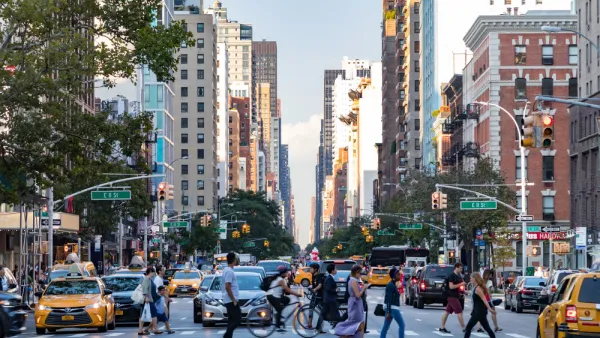Want to know how many people drive in your city? The answers are easy to find. But for anyone trying to find out how many people bike and walk, it's not so easy. The result is problematic for safety and spending advocates alike. This may soon change.
“The current state of bike/ped counts is way behind where it should be,” said Darren Flusche, policy director at the League of American Bicyclists. “We know a lot about how to count cars but not a lot about how to count bikes.”
So why is it a big deal that data collection on walking and biking is less rigorous than for other modes?
For one, look at the recent traffic fatality findings. While auto deaths have seen a steep decline of late, pedestrian and bike fatalities are up. Is this the result of more pedestrians and bicyclists on the streets, or is something more insidious to blame? With a lack of sound data, experts can only speculate.
"Better measurement tools are especially important because the new transportation bill, MAP-21, emphasizes 'performance measures' in selecting projects for federal funding," notes Schmitt. "Having a weak sense of how many people are actually biking and walking makes it difficult to build a strong, data-based case for increased investment in infrastructure to support those activities."
“We live in a world where our decisions are increasingly based on data,” Flusche said. “If you don’t have good data, you can’t make good decisions.”
Thankfully, reports Schmitt, "[t]he state of bike/ped data may soon improve. For the first time this year, the Federal Highway Administration has issued recommendations for “non-motorized” groups in its Traffic Monitoring Guide [PDF]. States and localities still have to want to collect data — there’s no one forcing them to do it — but this will be the first time that the 'bible' for traffic counts even contemplates cyclists and pedestrians in its guidance."
"The guide sets out to help agencies decide what method is best for their purposes: manual or automatic counters, long or short-term measurement periods, and so on. It also advises transportation professionals about how to interpret the data — which, given the limited information currently available, has been very difficult to do."
FULL STORY: Finally Getting Serious About Measuring How Much People Walk and Bike

Analysis: Cybertruck Fatality Rate Far Exceeds That of Ford Pinto
The Tesla Cybertruck was recalled seven times last year.

National Parks Layoffs Will Cause Communities to Lose Billions
Thousands of essential park workers were laid off this week, just before the busy spring break season.

Retro-silient?: America’s First “Eco-burb,” The Woodlands Turns 50
A master-planned community north of Houston offers lessons on green infrastructure and resilient design, but falls short of its founder’s lofty affordability and walkability goals.

Test News Post 1
This is a summary

Analysis: Cybertruck Fatality Rate Far Exceeds That of Ford Pinto
The Tesla Cybertruck was recalled seven times last year.

Test News Headline 46
Test for the image on the front page.
Urban Design for Planners 1: Software Tools
This six-course series explores essential urban design concepts using open source software and equips planners with the tools they need to participate fully in the urban design process.
Planning for Universal Design
Learn the tools for implementing Universal Design in planning regulations.
EMC Planning Group, Inc.
Planetizen
Planetizen
Mpact (formerly Rail~Volution)
Great Falls Development Authority, Inc.
HUDs Office of Policy Development and Research
NYU Wagner Graduate School of Public Service



























